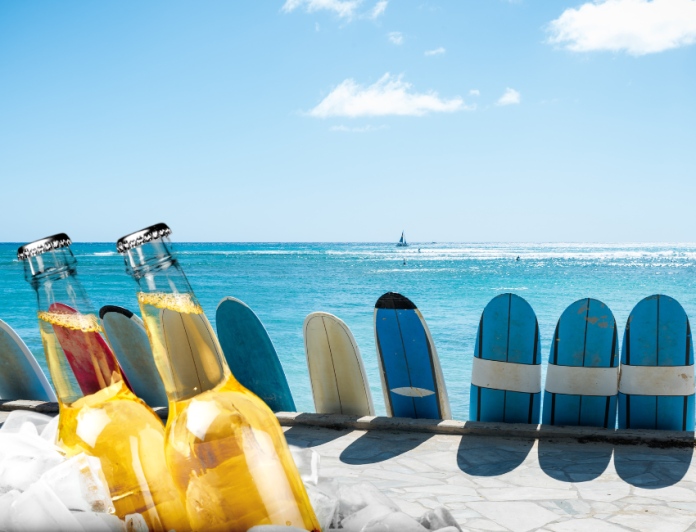Surfers aren’t usually what comes to mind when you think of someone at the forefront of a culinary trend. But that’s the case with Mexico’s iconic Pacífico beer.

Today this outstanding pilsner-style lager is one of the most popular brews in the world. But Pacífico had been in Mexico for more than 100 years before a twist of fate—and some thirsty California surfers—catapulted it into the international arena. Those humble beginnings are the basis of the brand’s slogan: “Born in Mazatlán, found in Baja, imported by surfers.”
The adventurous surfers not only found good waves but a great local beer, and they loaded up their vehicles with cases of it to bring home. During the 1970s, Pacífico became the legendary drink of choice in the Southern California surf community, but it wasn’t until 1985 that it began to be legally imported to the U.S.
Pacífico’s crisp, refreshing “ocean mist” flavor results from high-quality, specially grown hops and barley and a secret process for roasting its distinctive malts. Serious drinkers might even compare its flavor profile to high-quality German beers—and they’d be correct.
It was a trio of German immigrants in the seaside town of Mazatlán, Sinaloa, who created Pacífico beer. Jorge Claussen, Germán Evers and Emilio Philipy opened Cervecería del Pacífico brewery in 1899 and released the first bottle of Pacífico a year later. The men were so influential and involved in the city that their names still grace some main streets and government buildings today. Pacífico has been a proud sponsor of many of Mazatlán’s annual events for generations, including Carnaval and Moto Week.
They were part of an explosion of immigrants and German-style breweries opening in Mexico from the 19th to early 20th centuries, drawn by the short-lived reign of Austrian archduke Maximilian I of Mexico, an elected president of the equally short-lived Second Mexican Empire. The influx of German immigrants brought with them their love of beer, along with their homeland’s polka music, which transformed into Sinaloa’s famous horn-heavy banda—but that’s another story. Beer would eventually replace pulque as the most popular fermented beverage in Mexico.
The original Pacífico brewery still operates in Mazatlán’s Centro Histórico. Until about 10 years ago it was open to the public for tours that ended in a rooftop tasting room filled with historic photographs and a 360-degree view of the city. Grupo Modelo, which took over the operation in 1954, was bought by beer conglomerate Anheuser-Busch InBev in 2013 and the tours ended.
Mexico-based Grupo Modelo also markets Corona, Negra Modelo and Modelo Especial for export and Victoria, Leon and Montejo brands for domestic consumption. Corona is Mexico’s best-selling beer, and one of the top five most-consumed beers in the world. Pacífico and Corona are both pilsners, with a 4.5% alcohol content but made with slightly different formulas. Today, 80% of imported beers in the U.S. come from Mexico, which exports twice as much beer as any other country.
AB-InBev, the largest beer company in the world, and Heineken N.V. (makers of Tecate) control 90% of the beer market. That rivalry between Pacífico and Tecate drinkers? It’s based on taste and very real.
There’s an urban legend that in Mazatlán beer is cheaper than water. In the case of Pacifico, that’s often true, especially during holidays or big events. Pacifico is available in four sizes: cute little 6 oz. cuartitos, regular 12 oz. medias, tubby 32 oz. ballenas, and the so-big-you-have-to-see-it-to-believe-it 1.2 liter-ballenóns. (Today’s Spanish lesson: ballena means whale; ballenón means a really big whale.) Those big sizes are one of Mazatlán’s claims to fame, historically only available in that Pacific coast town, where one of the most popular tourist photo ops is relaxing on the beach, ballena in hand.
Janet Blaser is the author of the best-selling book, Why We Left: An Anthology of American Women Expats, featured on CNBC and MarketWatch. She has lived in Mexico since 2006. You can find her on Facebook.
